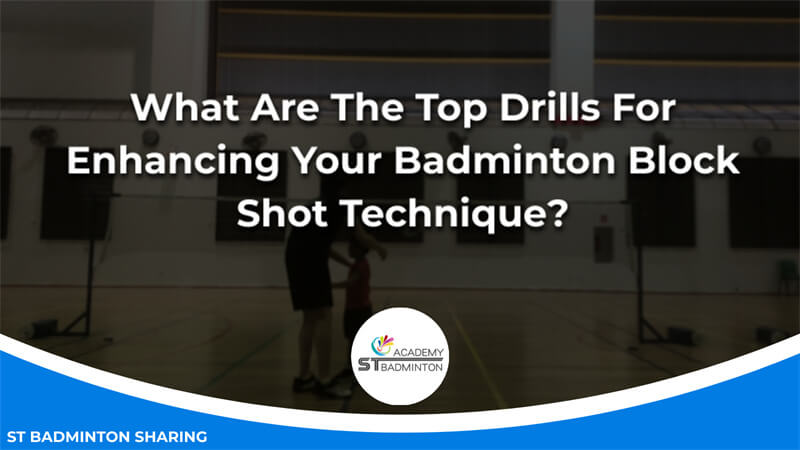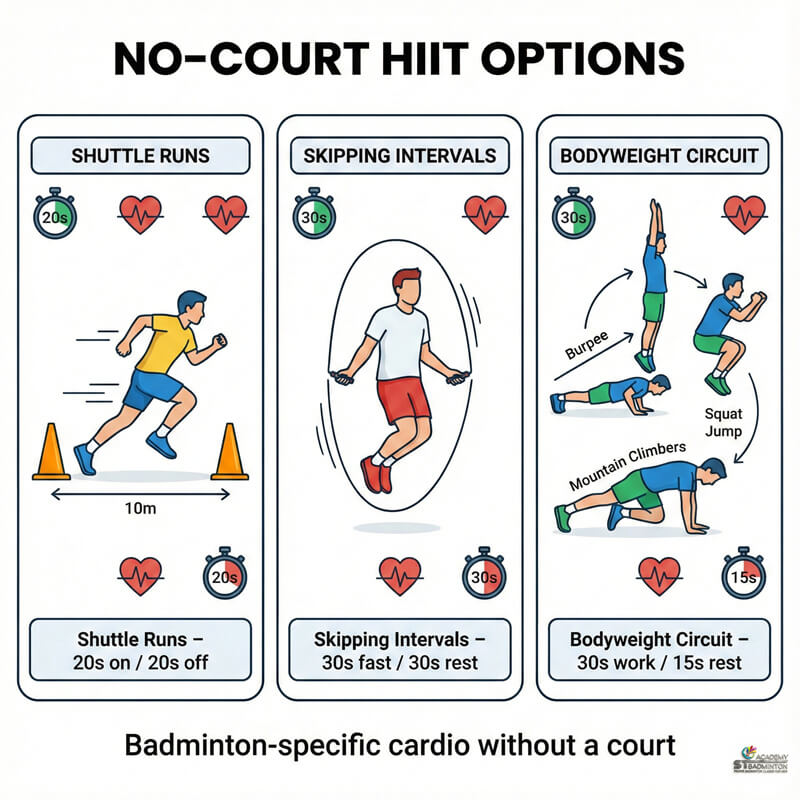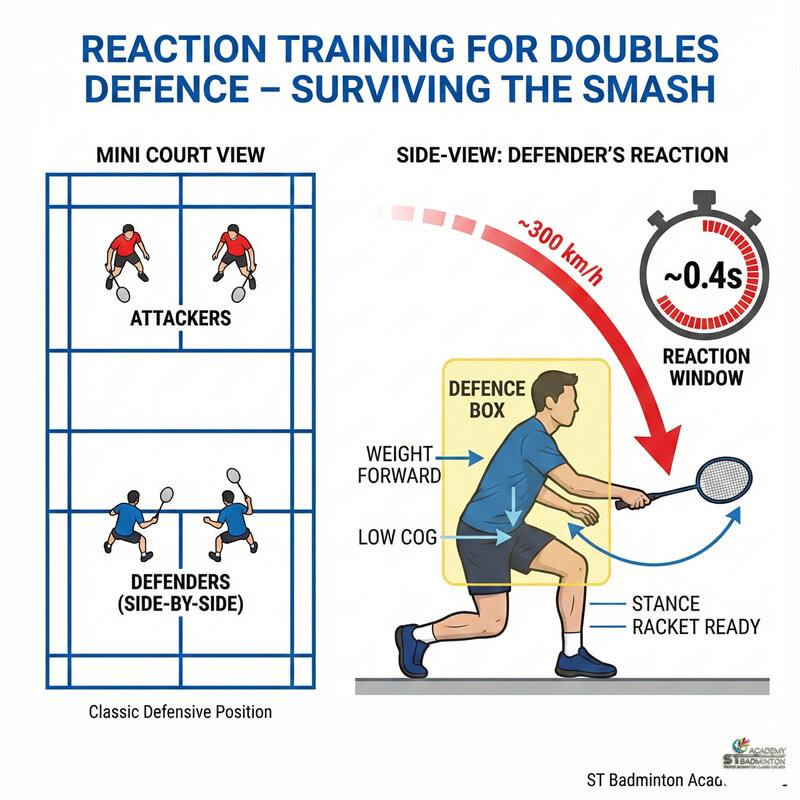Welcome to ST Badminton Academy’s badminton training in Malaysia! I’m Coach Eric and today I’m here to talk about the top drills for enhancing your badminton block shot technique. As a seasoned badminton coach with over 15 years of experience, I know just how important it is to have effective blocking techniques if you want to be successful in this sport. If you’re serious about improving your game, then these drills will help you become more consistent and accurate when making blocks. Read on to learn more!
Shadow Blocking
Shadow blocking is a great way to get your badminton block shot technique down pat. In this drill, you mimic the movements of an actual badminton match and practice responding to different ball speeds, shots, placements, and spins. I like to have my players mix up their grips – both forehand and backhand – while shadow-blocking with varying speeds.
This will help them develop precision in their blocks so they can be better prepared for any incoming shuttlecock. Knowing how to use various techniques such as hitting hard when needed or softening the hit at times is key to success. Plus, it’s important that you stay loose even under pressure – don’t forget to keep breathing! With effective shadow-blocking drills, you should start noticing improvements in your block shots right away. Now let’s move on to stationary blocking…
Stationary Blocking
Now that we’ve gone over the basics of shadow blocking, it’s time to move on to stationary blocking. This form of defense is an important part of badminton and requires good footwork drills in order to make sure your body positioning is correct for a successful block shot. In this section, I will cover two drills that can help you improve your technique: crosscourt drills and side-to-side drills.
To begin with, let’s look at crosscourt drills. You need to practice getting yourself into the right position quickly so you are ready when the shuttlecock comes toward you. Start by standing in front of one corner of the court, then run diagonally across to another corner – imagine there’s a shuttlecock coming straight down at you from each point as you do this drill. Practice running back and forth between these corners until your movement becomes automatic; after all, if you don’t have good footwork, how can you be expected to hit a successful block?
The second drill involves moving side-to-side along the baseline because sometimes during play, opponents may try to throw off your rhythm by sending shots directly parallel or close to the net rather than across it.
To prepare for this kind of tactic, stand slightly away from either edge of the court and practice shuffling laterally – step left with one foot while bringing up your other foot next to it in quick succession – as if someone is hitting shuttles just past the net towards both edges. Do this repeatedly until it becomes natural reflex action and always keep your eyes on the birdie! Now that we’ve covered basic stationary blocking techniques, let’s talk about defending against shots directed sideways…
Side To Side Blocking
Ok, let’s talk about improving your blocking technique! First off, let’s focus on footwork drills. You want to practice quick, precise movements to get into position for the block shot. Next, we’ll cover arm positioning drills. Here, you want to make sure you’re keeping your arms close to your body and positioning them correctly to best block the shot. Alright, let’s run through these drills and see how they can help you improve your blocking technique!
Footwork Drills
Are you a badminton player looking to improve your blocking technique? Well, I’ve got some drills that will take your side-to-side blocking game up a notch! When it comes to multi-directional blocking, footwork is key. You want to be able to quickly and efficiently move from side to side in order to keep the shuttle under control. To help hone this skill, try these three drills: stepping drill, crossover step drill, and lateral shuffle drill.
Let’s start with the stepping drill. For this one, stand at the back of your court facing the net. Use short steps and small jumps as you quickly shift from side-to-side on each shot. Make sure you don’t cross your feet when doing so! Get into a rhythm as you move between shots and soon enough you’ll feel like an expert blocker out there.
The next two drills require more precise movement than the first one. The crossover step drill requires that every time you jump or step forward (or backward) with either leg, you must use both legs together before moving onto the next direction – similar to how skaters skate sideways across ice rinks. Lastly, for the lateral shuffle drill, stay low as you do quick shuffles from one side of the court to another while controlling where exactly on your racket frame that shuttle lands upon contact – keeping it away from your opponents’ reach! With consistent practice of these drills, I’m confident that any badminton player can become proficient in their multi-directional blocking skillset!
Arm Positioning Drills
Now that you’ve got your footwork drills down, let’s talk about arm positioning. This is where a lot of players tend to struggle when it comes to blocking – they just don’t know how to hold their racket properly in order to execute each shot accurately! Don’t worry though, I have two great drills that can help you out with this. First, there’s the reaction drill which focuses on timing and accuracy.
Stand at the back of your court facing the net like before and hit short shots continuously from side to side. As the shuttle moves across the court, focus on readjusting your grip and racket position for optimal control over the shuttle. The second one is the footwork drill: practice keeping your left arm close to your body while shifting quickly between shots as you move around the court. Doing these two drills will ensure that you always maintain proper form no matter what direction or angle that shuttles comes from! With consistent practice of both drills, I’m sure any badminton player can become an expert blocker in no time!
Blocking With A Partner
The key to a successful block shot technique is practice and repetition. To hone your skills, it’s important to make sure you’re getting the most out of each drill. Here are three essential drills for improving your badminton blocking technique:
1. Weighted Drills – This type of drill involves hitting heavier objects such as medicine balls or racquet weights in order to increase power and accuracy when executing the block shots. It can also help develop coordination between feet, arms, and eyes while maintaining proper form.
2. Cross Court Drills – These involve performing blocks across the court from one side to another. The goal here is to learn how to reach distant shots quickly while still being able to deliver an effective block return. This will sharpen quickness off the mark as well as hand-eye coordination.
3. Volley Blocking Drill – A good drill to work on timing, this requires two players (or partners) where one serves and the other attempts volley blocks until either player makes a mistake or fails to hit back properly. This helps with reaction time and developing defensive strategies against specific types of shots by anticipating them better.
By incorporating these weighted drills into any practice session, your badminton blocking techniques will become sharper than ever before! With consistent effort over time, soon enough you’ll be ready for that next big tournament match up and ready to take on whatever challenges come your way. Now let’s move onto returning serve blocking which can give a whole new dynamic when playing opponents who are particularly adept at serving…
Return Of Serve Blocking
Return of Serve Blocking is an essential skill to master when playing badminton. It’s important to ensure you have the correct return positioning, as this will give you a better angle for your block shot. You also need to pay attention to where the opponent places their serve, as this can drastically affect how successful your block shot will be. I like to tell my students that having good footwork and being able to adjust quickly are key components in making sure they’re always in the best position possible when returning a serve.
When executing your block shot it’s important not only to concentrate on getting the shuttle over the net but also keeping it away from your opponents reach. To do this properly you’ll want to make sure you’ve moved into position before actually hitting the shuttlecock, so that you can get maximum power out of each hit without sacrificing accuracy or control. Additionally, using spin variation can help disguise which direction you intend for the shuttlecock to go, allowing for more strategic playmaking during rallies.
Working on these techniques regularly will enable players to become more confident with their blocking skills, giving them an edge against even some of their toughest competitors. With practice and patience, mastering Return of Serve Blocking should come naturally! This opens up new possibilities such as wall blocking which we will discuss further in our next section…
Wall Blocking
Wall blocking is an important technique for any badminton player to master. To effectively block shots, you must be in the correct position and have good net coverage. The most effective way to improve your wall blocking technique is through footwork drills.
Let’s take a look at one example: imagine that your opponent has hit a crosscourt shot deep into the backcourt. In order to reach this shot and make sure it doesn’t fall, you need to move quickly from side to side while keeping your racket close to the net. This requires fast feet and precise movement to get across the court in time.
Footwork drills are essential for improving your wall-blocking skills; practice moving quickly from side to side with small steps so you can react quickly when needed. You can also do shuttlecock drills where you pick up and drop shuttlecocks on either side of the court as quickly as possible – this will help condition your body for quick movements during gameplay. With consistent practice and repetition, these drills will help improve both reaction time and positioning when defending against opponents’ shots.
Having mastered wall-blocking techniques, we now turn our attention to drop shot blocking – another crucial defensive skill in badminton.
Drop Shot Blocking
When it comes to improving your badminton block shot technique, there are a few drills that can help. One of the most important ones is serving practice. This gives you an opportunity to get used to the speed and direction of incoming shots so you know how to respond when blocking. You should also try out some specific blocking drills like stationary blocks or alternating forehand-backhand blocks. These will help develop accurate timing and effective footwork for successful blocks.
Another important drill for enhancing your block shot technique is shadowing with a partner. Have one person hit balls toward the other while they work on their defensive position and balance before initiating contact with the shuttlecock. It’s essential to stay low as much as possible while still having enough power in each stroke to keep up with fast shots from opponents. Working in tandem with another player allows both partners to learn proper body positioning, which is key for any good block shot.
Finally, don’t forget about reaction drills! Set up multiple shuttles near the frontcourt area and have someone feed random shots at different angles and speeds – this helps improve agility and reflexes under pressure situations during matches. With these types of drills combined with regular practice, your block shot technique will be sure to improve in no time! As we move onto forehand and backhand blocking, let’s take a look at what type of training strategies are best suited for those particular skill sets…
Forehand And Backhand Blocking
If you thought honing your drop shot blocking technique was tough, then wait till you experience the challenge of mastering forehand and backhand blocks. As badminton aficionados are well aware, these strokes require precision, agility, and a keen eye for court positioning – all at once. It’s almost like trying to juggle three balls in one hand! Fortunately with practice, patience, and some hard work, it is possible to master this skill-set that will give you an edge over your opponents.
Let’s start off by breaking down how footwork drills can help enhance your block shots. Firstly, as far as possible try and stay light on your feet while playing up close to the net; think of yourself like a cat ready to jump onto its prey! Secondly, be sure to maintain good balance throughout each stroke so that you don’t lose momentum during play. Finally, focus on getting into position quickly after delivering each stroke – this will ensure that you are always ahead of the game when anticipating where your opponent is going next.
The second aspect which needs attention is effective court positioning when moving around the front court area. Here’s where a combination of anticipatory skills along with quick reflexes comes in handy. Always keep an eye out for any potential openings or weak spots that could be exploited by either player and adjust accordingly depending on what type of shot has been played. This might seem daunting at first but rest assured it gets easier with time as long you make conscious efforts towards improving every single day.
Frequently Asked Questions

What Type Of Footwork Should I Use When Attempting A Block Shot?
When attempting a block shot, the most important aspect of your footwork is to ensure consistent timing. This will help you develop hand speed and better anticipate your opponents’ shots. So practice quick steps that allow you to shift quickly into position as soon as they hit their shot. Make sure to also stay low in your stance so you can move faster and react quicker when switching between defensive and offensive positions. With some practice, these techniques should help improve your badminton block shot technique.
How Do I Know When To Use A Block Shot Instead Of A Smash?
Ah, the age-old question – when do I use a blocked shot instead of a smash? Well, it all comes down to reading your opponent’s cues and timing. As any badminton coach will tell you, being able to read your opponents’ intentions is key in deciding whether you should go for a block or a smash.
If they’re set up for speed, then smashing may be the way to go; however, if they’ve adjusted their stance for control and accuracy, blocking might be the better option. Timing also plays an important role: too early and you won’t have enough time to adjust your technique accordingly; too late and you’ll miss out on that point!
So keep practicing those footwork drills from before until you get comfortable with knowing when and how to properly execute either a block shot or smash.
What Is The Best Way To Practice Blocking Shots?
If you’re looking to practice your blocking shots, timing drills, and controlled shots are the way to go. To master this technique, I recommend starting with a simple drill: stand in front of the net facing an opponent and have them hit slow, consistent shots at you while you focus on returning them back with blocks.
This will help you get used to the feeling of timing each shot and controlling your movements as you block. Once you’ve got that down, try adding more distance between yourself and the incoming shuttlecock for added difficulty. Other than choosing a good racket and also remember to choose the best racket restring in Malaysia.
What Grip Should I Use When Blocking?
When it comes to blocking shots, having a consistent grip and placement is key. The most common grip used for blocking is the forehand grip – this involves holding the racket with your thumb on top of the handle and all four fingers underneath.
In order to improve your timing when blocking, you should practice drills such as quick footwork drills or defensive position drills. These will help you react faster and place yourself in the correct stance so that you can make successful blocks.
Is There A Specific Way To Position My Racket When Blocking?
It’s all about getting the timing and positioning just right when it comes to blocking in badminton. Sure, you can use any grip that feels comfortable, but if you don’t have your racket angled correctly and with proper body posture you won’t be able to block the shuttlecock effectively.
That’s why timing drills and power drills are essential for improving your technique – they’ll help you get a handle on exactly how to position your racket at the right moment. As an instructor or coach, I’d recommend focusing on these two types of drills as they will go a long way towards helping players perfect their block shot technique!
Learn Professional Block Shot Technique in Badminton Training Malaysia
As a badminton coach, I often get asked about the best drills to enhance block shot technique. Ultimately, mastering this skill requires consistent practice and dedication. It is important for players to work on their footwork and timing when attempting a block shot as well as learn when it’s appropriate to use one instead of a smash. Additionally, having the right grip and racket position will help improve accuracy in blocking shots.
While some might think that learning how to master this skill takes too much effort, with these techniques you can easily become an expert at executing perfect block shots!





